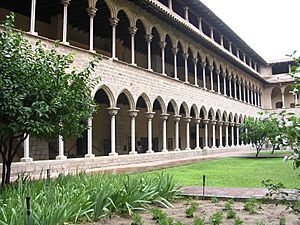Monastery of Pedralbes facts for kids
The Monastery of Pedralbes, also known as the Royal Monastery of Santa Maria de Pedralbes, is a beautiful old building in Barcelona, Spain. It was built in the Gothic style, which means it has tall arches and detailed stone work. Today, it is a museum where you can see amazing art and learn about its long history. The Chapel of St. Michael, a special part of the monastery, was fixed up and opened again in 2018.
Contents
What Does Pedralbes Mean?
The name "Pedralbes" comes from two old Latin words: Petras Albas. This means "white stones." The monastery was built with light-colored stone, which is how it got its name!
History of the Monastery
How It Started
The Monastery of Pedralbes was started in 1326 by King James II of Aragon. He built it for his wife, Queen Elisenda de Montcada. The monastery was home to a group of nuns called the Poor Clares. Many of these nuns came from important noble families.
Queen Elisenda's Role
Queen Elisenda gave the monastery special rights. One important right was that the city of Barcelona would protect it. The city's "Council of the Hundred" (called the Consell de Cent) was in charge of keeping the monastery safe. After her husband died in 1327, Queen Elisenda lived in a palace next to the monastery. She passed away there in 1367. Parts of her old palace were found in the 1970s.
Later Years
During a conflict in the 1640s and 1650s, the nuns had to leave the monastery for a short time. But they later returned. Some nuns still live in the complex today. The monastery was declared a national monument in 1991, meaning it is a very important historical site.
What the Monastery Looks Like
The Walls and Church
The monastery was originally surrounded by strong walls. These walls were made of the "white stones" that gave the place its name. Today, only two towers and one gate from these old walls remain.
The church inside the monastery has one main open space, called a nave. Its ceiling has special arched supports called rib vaults. The back part of the church, called the apse, has many sides. Inside, you can see a beautiful Gothic altarpiece made by Jaume Huguet. The front of the church has a large, round stained-glass window called a rose window.
The Cloister
The cloister is a peaceful open area with a garden in the middle. It has three floors and is about 40 meters long. The garden is filled with orange trees and palm trees. The cloister has wide arches supported by columns. The tops of these columns, called capitals, are decorated with symbols of the Kings of Aragon and the House of Montcada. Queen Elisenda's tomb, made of alabaster stone, is located in one part of the cloister.
Chapel of St. Michael
The Chapel of St. Michael is another important part of the monastery. It has amazing fresco paintings by Ferrer Bassa. These paintings were made in 1346 and show the influence of the famous Italian painter Giotto.
Former Art Exhibitions
In the 1990s, the monastery's old dormitory was used to show art from the Thyssen-Bornemisza Collection. This collection included works by early Italian painters and later artists like Rubens, Canaletto, Tintoretto, Velázquez, and Fra Angelico. One of Fra Angelico's most famous paintings, Virgin of Humility, was displayed there. These artworks are now in the Museu Nacional d'Art de Catalunya in Barcelona or in the main collection in Madrid.
Notable People
- Isaura Marcos Sánchez (born 1959), a nun who lives at the monastery and is also a photographer.
See also
 In Spanish: Monasterio de Santa María (Pedralbes) para niños
In Spanish: Monasterio de Santa María (Pedralbes) para niños
- Maritime Museum of Barcelona


